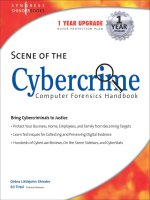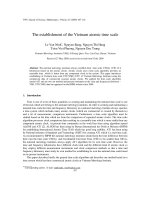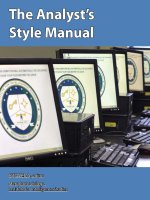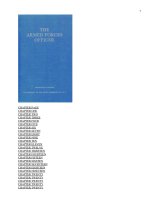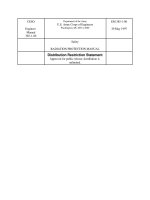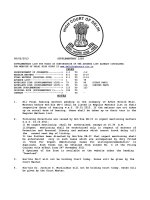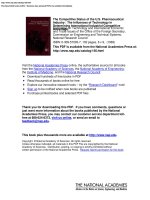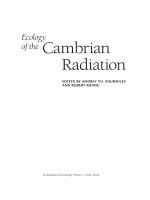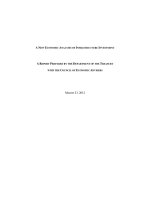Department of the Army radiation protection manual docx
Bạn đang xem bản rút gọn của tài liệu. Xem và tải ngay bản đầy đủ của tài liệu tại đây (1.91 MB, 175 trang )
CESO
Engineer
Manual
385-1-80
Department of the Army
U.S. Army Corps of Engineers
Washington, DC 20314-1000
EM 385-1-80
30 May 1997
Safety
RADIATION PROTECTION MANUAL
Distribution Restriction Statement
Approved for public release; distribution is
unlimited.i
DEPARTMENT OF THE ARMY EM 385-1-80
U.S. Army Corps of Engineers
CESO Washington, D.C. 20314-1000
Manual 30 May 1997
No. 385-1-80
Safety
RADIATION PROTECTION MANUAL
Table of Contents
Subject Para. Page Subject Para. Page
Chapter 1. Organization of USACE
Radiation Protection Program.
Purpose 1-1 1-1
Applicability 1-2 1-1
Policy 1-3 1-1
Management Commitment,
Involvement, and
Leadership 1-4 1-2
Scope 1-5 1-2
Overview of this
Manual 1-6 1-3
Chapter 2. USACE Personnel
Responsibilities and Qualifications.
The Chief, Safety and
Occupational Health
Office, HQUSACE 2-1 2-1
Radiation Protection
Staff Officer 2-2 2-1
USACE Commanders 2-3 2-2
Radiation Protection
Officer 2-4 2-3
Laser Safety Officer 2-5 2-4
Qualified Health
Physics Personnel 2-6 2-5
Authorized Users 2-7 2-5
Authorized Users’
Assistants 2-8 2-7
Site Supervisors 2-9 2-7
Project/Plan/Procedure
Originators and
Reviewers 2-10 2-8
Radiation Protection
Committee 2-11 2-9
Hazardous, Toxic and
Radioactive Waste
(HTRW), Center of
Expertise 2-12 2-9
Refresher Training 2-13 2-10
Additional Training/
Special Applications 2-14 2-10
All Personnel including
Visitors at a Radiation
Site 2-15 2-10
Chapter 3. Introduction to
Radiation.
Atomic Structure 3-1 3-1
Radioactive Decay 3-2 3-1
Activity 3-3 3-2
Decay Law 3-4 3-3
Types of Ionizing
Radiation 3-5 3-4
EM 385-1-80
30 May 97
ii
Interaction of
Radiation With Matter 3-6 3-6
Human Health Effects 3-7 3-8
Determinants of Dose 3-8 3-9
Background Radiation 3-9 3-11
Radiation Quantities 3-10 3-12
Biological Effects
of Ionizing Radiation 3-11 3-16
Ways to Minimize
Exposure 3-12 3-18
Standing Operating
Procedures 3-13 3-21
Monitoring and
Surveying Equipment 3-14 3-21
Chapter 4. Licensing.
Overview of
Regulatory Agencies 4-1 4-1
Types of NRC
Radioactive Material
Licenses 4-2 4-1
'Storage Only'
Licensing 4-3 4-4
Radiation Generating
Devices 4-4 4-4
Reciprocity
Requirements 4-5 4-4
Army Radiation
Authorization 4-6 4-5
Army Radiation Permits
and Other Service
Installation Permits 4-7 4-5
Applying for an NRC
License 4-8 4-7
Applying for an ARA 4-9 4-9
Amendment Requests 4-10 4-9
Renewing Licenses or
ARAs 4-11 4-10
Transfer of Radioactive
Materials 4-12 4-10
Terminating a
Radioactive Material
License or ARAs 4-13 4-11
Information Flow
through Applicable
USACE Channels 4-14 4-11
Chapter 5. Dose Limits and ALARA.
Occupational Dose
Limit Structure 5-1 5-1
USACE Dose Limits 5-2 5-1
NRC and Agreement State
Dose Limits 5-3 5-3
OSHA Dose Limits 5-4 5-4
Monitoring requirements 5-5 5-4
Doses to the Public 5-6 5-4
Chapter 6. Working with Radiation.
Caution Signs and
Labels 6-1 6-1
Airborne Radioactivity 6-2 6-3
Rooms/Areas in Which
Radioactive Material is
No Longer Used
or Stored 6-3 6-3
Receiving Radioactive
Material 6-4 6-3
Radioactive Material
and Radiation
Generating Device
Inventory 6-5 6-6
Storing Radioactive
Material 6-6 6-6
EM 385-1-80
30 May 97
iii
Contamination Control 6-7 6-7
Wipe Tests 6-8 6-8
Leak Testing 6-9 6-9
Exposure Rate Surveys 6-10 6-10
Accident/Incident
Response 6-11 6-11
Accident/Incident
Reporting 6-12 6-11
Audits and Reviews 6-13 6-13
Chapter 7. Personnel Monitoring.
External Monitoring 7-1 7-1
Internal Monitoring 7-2 7-2
Advanced Monitoring 7-3 7-4
Exposure Reporting 7-4 7-5
Chapter 8. Transportation of
Radioactive Material.
Purpose 8-1 8-1
Applicability 8-2 8-1
Regulations 8-3 8-1
Procedures 8-4 8-2
Packaging 8-5 8-2
Marking 8-6 8-3
Labeling 8-7 8-4
Placarding 8-8 8-5
Manifesting 8-9 8-5
Hazardous Waste
Manifesting 8-10 8-6
Emergency Response
Information 8-11 8-7
Hazmat Employee
Training 8-12 8-7
Exceptions 8-13 8-8
Chapter 9. Waste Management.
Regulation of
Radioactive Wastes 9-1 9-1
Low Level Radioactive
Waste (LLRW) 9-2 9-2
Elements of a Waste
Management Program 9-3 9-4
Material Tracking 9-4 9-4
Waste Minimization 9-5 9-4
Waste Recycling 9-6 9-4
Waste Storage 9-7 9-5
Waste Disposal 9-8 9-5
Radionuclide
Concentrations 9-9 9-7
Chapter 10. Laser Safety.
Classifications of
Lasers 10-1 10-1
Safety features and
Labeling Requirements 10-2 10-1
Laser Protection
Program 10-3 10-2
OSHA Standards 10-4 10-3
USACE Standards 10-5 10-3
Protective Eyewear 10-6 10-3
Chapter 11. Radio Frequency (RF) and
Microwave Safety.
DA Limits 11-1 11-1
USACE Limits 11-2 11-1
OSHA Regulations 11-3 11-1
EM 385-1-80
30 May 97
iv
General Guidance 11-4 11-1
Warning Signs 11-5 11-2
RF Safety Training 11-6 11-2
Appendix A.
References A-1
Appendix B.
Definitions B-1
Appendix C.
Sample Standing Operating
Procedures C-1
Appendix D.
X-Ray Fluorescence Lead Analysis
Devices D-1
Appendix E.
Rules of Thumb and Conversions E-1
Appendix F.
Signs, Labels and Postings F-1
Appendix G.
Radon G-1
Appendix H.
Applications and License Examples,
Applicable Forms and Statements H-1
Appendix I.
USACHPPM Survey Protocol
Checklist I-1
Appendix J.
Acronyms Used in this EM J-1
EM 385-1-80
30 May 97
1-1
Chapter 1. Organization of
USACE Radiation Protection
Program.
1-1. Purpose.
This guidance manual prescribes
the requirements of the
Radiation Protection Program of
the US Army Corps of Engineers
(USACE) contained in Engineer
Regulation (ER) 385-1-80,
Ionizing Radiation Protection,
and Engineer Manual (EM)385-1-
1, Safety and Health
Requirements Manual. It is to
be used when activities utilize
or handle radioactive material
(which includes radioactive
wastes) or a radiation
generating device. Radiation
generating devices include X-
ray equipment, accelerators,
lasers, radio-frequency and
electromagnetic field
generators. Authoritative
guidance and regulations are
contained in 10 CFR (Energy)
and the NRC Regulatory Guides,
29 CFR (Labor) 1910 and 1926
OSHA regulations, and 40 CFR
(Protection of the
Environment). This manual is
intended to assist USACE
Commands in integrating
essential requirements
contained in Federal, DA and
USACE radiation protection
regulations to ensure that the
safety and health requirements
of all agencies are met.
1-2. Applicability.
This manual is applicable to
USACE personnel and visitors to
a worksite under the
jurisdiction of USACE where
radioactive material or a
radiation generating device may
be present. It shall be used
in conjunction with ER 385-1-80
and EM 385-1-1.
Contractor
requirements concerning
ionizing and non-ionizing
radiation protection issues are
contained in EM 385-1-1
.
1-3. Policy.
a. USACE will work to
ensure that all personnel
radiation exposure is kept as
low as is reasonably achievable
(ALARA) taking technological
and socioeconomic factors into
account. Radiation exposure to
USACE personnel, visitors and
contractors, as well as to the
general public, will be con-
trolled so that exposures are
held well below regulatory
limits. There shall be no
radiation exposure without a
commensurate benefit.
b. All personnel involved
with ionizing radiation work of
any kind will be knowledgeable
of the programs, policies, and
procedures contained in ER 385-
1-80 and this manual. Personnel
working with non-ionizing
radiation should be
knowledgeable of the specific
information concerning these
topics presented in this
manual. They should
demonstrate responsibility and
EM 385-1-80
30 May 97
1-2
accountability through an
informed, disciplined, and
cautious attitude toward
radiation and radioactivity.
c. Continuing improvement
in radiation (ionizing and non-
ionizing) protection is
essential to USACE operations
involving radiation. All
personnel working with
radiation are expected to look
for ways to improve radiation
protection and make USACE
projects more efficient.
1-4. Management Commitment,
Involvement, and Leadership.
Superior, consistent
performance is achieved when
qualified personnel use
approved procedures and when
management actively monitors
the work place and assesses
ongoing activities. To achieve
such performance requires
constant review, informed
involvement and leadership by
senior management. All levels
of management must emphasize
the need for high standards of
radiation safety through direct
communication, clear
instruction, and frequent
inspections of the work area.
1-5. Scope.
a. This manual fully
describes policies and
procedures for the safe use of
radioactive material and
radiation generating devices at
all USACE sites. It should be
used to evaluate the
acceptability of health and
safety practices by USACE
personnel and contractors on
USACE controlled sites.
b. The manual is also
intended to be consistent with
all Federal (NRC, OSHA, EPA,
DOE, and DOT) DA, USACE, State,
and local statutes and
regulations (that is,
“applicable regulations”), and
integrate the various
regulations into one coherent
publication for USACE
operations. It will be revised
whenever necessary to achieve
consistency with statutes and
regulations.
c. For all contracts and
activities that require
Federal, State, or local
licensure or permitting, such
licenses or permits shall be
secured, and all license or
permit conditions shall be
adhered to. If the stated
license or permit conditions
vary from applicable sections
of this manual, such license or
permit conditions prevail.
Contractors will be required to
secure proper licensure or
permitting (for activities that
require it) within specified
time frames and before the date
that they are scheduled to
begin the work. All USACE
Commands and contractors using
Army radioactive materials
will meet requirements of
Nuclear Regulatory Commission
(NRC) licenses and Army
Radiation Authorizations (ARAs)
EM 385-1-80
30 May 97
1-3
issued to USACE and the US Army
Materiel Command, and of
applicable Army technical
publications.
e. Alternatives to
procedures addressed in this
manual may be acceptable
provided the alternatives
achieve the same, or higher,
level of radiation protection.
Alternative procedures must be
approved by the Radiation
Protection Officer, or Laser
Safety Officer, as appropriate,
and for specific conditions,
higher level authorities prior
to implementation.
1-6. Overview of this Manual.
This manual is designed to
address all health and safety
aspects of work with radiation
within USACE. Most personnel
within USACE will not need the
entire manual but will need to
select the chapters and
sections applicable to their
work requirements. Some
generic classifications of
radiation work are listed in
Table 1-1 with reference to the
applicable chapters of this
manual. It is recommended that
all personnel working with
radioactive material and
radiation generating devices
read Chapters 1, 2 and 3 of
this manual. Depending on the
type of work being performed,
portions of other chapters may
be applicable.
30 May 97
2-3
USACE Radiation Protection
Program and the record keeping
requirements for work with
radioactive material and
radiation generating devices.
(5) a working knowledge
of US Nuclear Regulatory
Commission (NRC), US
Environmental Protection Agency
(EPA), US Department of Energy
(DOE), US Department of
Transportation (DOT), and US
Department of Labor (DOL) which
is the responsible for the US
Occupational Safety and Health
Administration (OSHA), and US
Army regulations pertaining to
radioactive material and
radiation generating devices.
b. Duties of the RPSO are
as follows:
(1) Serve as the primary
liaison between USACE, DA and
NRC in matters concerning
radioactive materials or
radiation generating devices.
(2) All NRC license
actions will be submitted
through, reviewed, and accepted
by the RPSO.
(3) Provide a copy of all
correspondence relating to NRC
applications to DA as required.
The RPSO will retain copies of
all NRC radioactive material
licenses and correspondence
(originals will be retained by
the licensee).
(4) Ensure that each USACE
Command possessing an NRC
radioactive material license is
audited at least triennially to
ensure compliance with the
USACE Radiation Protection
Program. The RPSO, or
designee, will check for
compliance with the USACE
Radiation Protection Program
and the NRC radioactive
material license. The RPSO, or
his designee will document all
inspection findings and submit
them to the audited USACE
Command for review and action.
2-3. USACE Commanders.
USACE Commanders shall:
a. Ensure a Radiation
Protection Committee (RPC)
shall be formed when the
Command possesses an NRC
license with a condition
stating that the licensee shall
have a RPC, or if the Commander
considers an RPC necessary.
The RPC will consist of
personnel and duties described
in subparagraph 2-11.
b. Designate, in writing,
a qualified person to serve as
USACE Radiation Protection
Officer (RPO) when any of the
following is true:
(1) an NRC License, Army
Reactor Permit, ARA or
applicable technical
publication requires it,
(2) personnel are required
to wear dosimetry,
EM 385-1-80
30 May 97
2-4
(3) personnel are required
to participate in a bioassay
program.
c. Fund, maintain and
support the RPO and the
Radiation Protection Program.
The RPO shall meet the
qualifications and provide the
services described in paragraph
2-4.
d. Fund, maintain and
support the Laser Safety
Officer (LSO) and the Laser
Safety Program when a USACE
Command operates, maintains or
services a non-type-classified
class IIIb or class IV laser
system as defined in section
1.3, ANSI Z136.1. The RPO may
be designated as the LSO. The
LSO shall meet the
qualifications and provide the
services described in paragraph
2-5.
2-4. Radiation Protection
Officer (RPO).
a. The RPO (also known as
a Radiation Safety Officer
(RSO) in other documents) is a
person, designated by the USACE
Command, and tasked with the
supervision of the USACE
Radiation Protection Program
for that command. The RPO
shall have direct access to
the Commander for radiation
protection purposes. The RPO
ensures compliance with current
directives (AR’s, ER 385-1-80,
EM 385-1-1, etc.) for radiation
protection and with this
manual. The RPO may limit or
cease operations within their
Command where there is an
eminent and legitimate
radiation safety issue.
b. The RPO shall be
responsible for:
(1) Establishing written
policies and procedures to
assure compliance with
applicable Federal, DOD, and
Army radiation protection
regulations and directives.
These documents will include
emergency reaction plans as
necessary and procedures for
investigating and reporting
radiation accidents, incidents,
and overexposures.
(2) Assuring that all
personnel occupationally
exposed to radiation receive
appropriate radiation
protection training
commensurate with potential
hazards from radiation sources
they may encounter.
(3) Maintaining an
inventory of radiation sources
as higher headquarters directs
and IAW with requirements of
NRC licenses, Army reactor
permits, ARAs, and technical
publications.
(4) Approving and filing
records noting all Authorized
Users, Authorized Users’
Assistants and site supervisors
working with radioactive
materials or radiation
EM 385-1-80
30 May 97
2-5
generating devices within the
Command.
(6) Providing or securing
an acceptable source for all
required initial and annual
refresher training for all
individuals within the Command.
c. The RPO will review
the USACE Radiation Protection
Program for their Command
annually for content and
implementation. The RPO will
assure that the quality and
timeliness of the program meet
the radiation safety standards
outlined in this manual. The
RPO will review work with
radiation within the Command.
The RPO will write and/or
review Standing Operating
Procedures to ensure the
safety, timeliness, and
compatibility with existing
radiation regulations.
d. The RPO will be
technically qualified, meeting
the experience, training, and
education requirements listed
below:
(1) A working knowledge
of NRC, EPA, DOE, DOT, and US
Army regulations pertaining to
radioactive material, radiation
generating devices,
radioactive and mixed waste
used within their Command.
(2) Forty hours of formal
training covering:
(a) the physics of
radiation, radiation's
interaction with matter, and
the mathematics necessary to
understand the above subjects;
(b) the biological effects
of radiation;
(c) the instrumentation
necessary to detect, monitor,
and survey radiation, and the
use of such instrumentation;
and
(d) radiation safety
techniques and procedures.
This training will include the
use of time, distance,
shielding, engineering
controls, and PPE to reduce
exposure to radiation.
(3) Practical, hands-on
experience using radiation
instrumentation, procedures,
and theory.
(4) A working knowledge
of the Army Radiation
Protection Program and the
USACE Radiation Protection
Program, and the record keeping
requirements for work with
radioactive material and
radiation generating devices
used within their Command.
2-5. Laser Safety Officer
(LSO).
a. The LSO is a person
designated by the USACE Command
tasked with the supervision of
the Laser Sections of the USACE
Radiation Protection Program
EM 385-1-80
30 May 97
2-6
for that command. The LSO
ensures compliance with current
directives for laser safety (EM
385-1-1, TB MED 524, ANSI
Z136.1, etc.) and with this
manual.
b. The LSO will review
the USACE Laser Safety Program
for their Command annually for
content and implementation.
The LSO will assure that the
quality and timeliness of the
program meet the laser safety
standards outlined in this
manual. The LSO will write and
review Standing Operating
Procedures to ensure the
safety, timeliness, and
compatibility with existing
laser regulations.
c. The LSO will be
technically qualified, meeting
the experience, training, and
education requirements listed
below:
(1) A working knowledge of
applicable regulations
pertaining to lasers used
within their Command.
(2) Practical, hands-on
experience using lasers, laser
procedures, and laser theory.
(3) A working knowledge of
the Army Radiation Protection
Program and the USACE Radiation
Protection Program, and the
record keeping requirements for
work with lasers within their
Command.
2-6. Qualified Health Physics
Personnel.
A qualified Health Physicist
(HP) is responsible for
assisting the RPO with their
USACE Command Radiation
Protection Program, and
reviewing Scopes of Work, Work
Plans, and/or Site Safety and
Health Plans for all work
involving radiation. Qualified
HPs are personnel:
a. Meeting the Office of
Personnel Management Standards
for the HP Series, GS-1306, and
having three years experience
in work with radiation; or
b. Certified as a Health
Physicist by the American Board
of Health Physics, or certified
by the American Board of
Industrial Hygiene (Certified
Industrial Hygienist) and one
year experience working with
radiation; or
c. Identified as being a
qualified HP by the Director of
Army Radiation Protection, Army
Safety Office, or the Army
Surgeon General, and having
three years experience in work
with radiation.
2-7. Authorized Users (AUs).
AUs are individuals who, by
their training and experience,
are allowed to work,
unsupervised, with radioactive
material or radiation
generating devices. AUs may
EM 385-1-80
30 May 97
2-7
also directly supervise
Authorized Users Assistants
working with radioactive
material. All AUs must be
approved by the facility RPC,
if one exists. If the facility
does not require an RPC, the
AUs must be approved by the
RPO. All AUs must meet the
following training and
experience requirements:
a. A working knowledge of
applicable regulations
pertaining to radioactive
material, radiation generating
devices, and radioactive and
mixed waste with which they may
be working;
b. Unless different
requirements are stated in the
license, authorization or
permit conditions, eight clock
hours of formal training
covering:
(1) the physics of
radiation, radiation's
interaction with matter, and
the mathematics necessary to
understand the above subjects;
(2) the biological
effects of radiation;
(3) the instrumentation
necessary to detect, monitor,
and survey radiation, and the
use of such instrumentation;
and
(4) radiation safety
techniques and procedures.
This training will include the
use of time, distance,
shielding, engineering
controls, and PPE to reduce
exposure to radiation.
c. Practical, hands-on
experience using radiation
instrumentation and procedures.
The level of training will be
commensurate with the hazard
presented by the radioactive
material or radiation
generating device; and
d. A working knowledge of
the USACE and his or her USACE
Command Radiation Protection
Program, and the record keeping
requirements for the
radioactive material and
radiation generating devices
used in their work.
e. Instruction in their
rights and their
responsibilities under the
USACE Command NRC license, or
Army Radiation Authorization
(ARA). This includes:
(1) the employer’s duty to
provide safe working
conditions;
(2) a report of all
radiation exposure to the
individual;
(3) the individual's
responsibility to adhere to the
NRC’s regulations and the
Commands's radiation material
license, or ARA; and
(4) the individual's
EM 385-1-80
30 May 97
2-8
responsibility to report any
violation or other occurrence
to the RPO.
f. Authorized users of
portable gauges will also
receive 8 hours training in the
safety and use of the gauge
from the manufacturer.
2-8. Authorized Users’
Assistants (AUAs).
AUAs are individuals allowed to
work with radioactive material
only under the direct
supervision of an AU (that is,
in the physical presence of the
AU). All AUAs must be
nominated by the AU and
approved by the RPO. AUAs will
have the training and
experience described below:
a. A total of at least
four hours instruction in the
following:
(1) the health effects
associated with exposure to the
radioactive material or
radiation they work with;
(2) ways to minimize
exposure;
(3) the purpose and use of
protective equipment used in
their work; and
(4) the applicable
regulations to their work.
b. Practical, hands-on
experience using radiation
instrumentation and procedures.
c. Instruction in their
rights and their
responsibilities under the
USACE Command NRC license, or
ARA. This includes:
(1) the employer’s duty to
provide safe working
conditions;
(2) a report of all
radiation exposure to the
individual;
(3) the individual's
responsibility to adhere to the
NRC’s regulations and the
Command's radioactive material
license, or ARA; and
(4) the individual's
responsibility to report any
violation or other occurrence
to the RPO.
2-9. Site Supervisors/
Construction Quality Assurance
Personnel.
a. Individuals working as
site supervisors or
construction quality assurance
representatives on projects
involving radioactive material
or radiation generating devices
must be knowledgeable of: the
principles of radiation
protection; applicable
regulations pertaining to
radioactive material and
radiation generating devices,
and the application of these
principles and regulations to
worker and public health and
safety at project sites.
EM 385-1-80
30 May 97
2-9
b. Individuals who
supervise work or act as
construction quality assurance
representatives at sites
involving radioactive material
or radiation generating devices
will have a minimum of eight
hours of radiation safety
training covering the
following:
(1) physics of radiation,
radiation's interaction with
matter, and the mathematics
necessary to understand the
above subjects;
(2) biological effects of
radiation;
(3) instrumentation
necessary to detect, monitor,
and survey radiation, and the
use of such instrumentation;
and
(4) radiation safety
techniques and procedures.
This training will include the
use of time, distance,
shielding, engineering
controls, and PPE to reduce
exposure to radiation.
2-10. Project/Plan/Procedure
Originators and Reviewers.
a. Individuals who
originate or review projects,
plans, or procedures involving
radioactive material or
radiation generating devices
must be knowledgeable of the
principles of radiation
protection, the applicable
regulations pertaining to
radioactive material and
radiation generating devices,
and the application of these
principles and regulations to
worker and public health and
safety.
b. Originators and
reviewers of plans, projects or
procedures for work at sites
using radioactive material or
radiation generating devices
will have a minimum of eight
hours of radiation safety
training covering the
following:
(1) physics of radiation,
radiation's interaction with
matter, and the mathematics
necessary to understand the
above subjects;
(2) biological effects of
radiation;
(3) instrumentation
necessary to detect, monitor,
and survey radiation, and the
use of such instrumentation;
and
(4) radiation safety
techniques and procedures.
This training will include the
use of time, distance,
shielding, engineering
controls, and PPE to reduce
exposure to radiation.
2-11. Radiation Protection
Committee (RPC).
a. Each Command possessing
an NRC license or an ARA with a
EM 385-1-80
30 May 97
2-10
condition stating that the
licensee shall have an RPC, or
where the Commander deems
necessary, shall form an RPC.
At a minimum, the RPC will
consist of:
(1) The Commanding Officer
(CO) or deputy;
(2) The RPO, who will act
as recorder for all meetings;
(3) The Chief; Safety and
Occupational Health Office; and
(4) A representative
Authorized User from each group
using radioactive material or
radiation generating devices in
the Command.
b. The RPC is accountable
to its USACE Commander. The CO
or his/her deputy chairs the
RPC. The RPC will meet at least
once each six-month period and
at the call of the chair. The
RPC will continually evaluate
radiological work activities,
and make recommendations to the
RPO and management. In
addition to its
responsibilities established
in the Army Radiation
Protection Program, the RPC
responsibilities
include:
(1) Annual review of USACE
Command personnel exposure
records;
(2) Establishing criteria
for determining the appropriate
level of review and
authorization for work
involving radiation exposure;
and,
(3) Evaluating health and
safety aspects of the
construction and design of
facilities and systems and
planned major modifications or
work activities involving
radioactive material or
radiation generating devices.
c. The RPO will furnish
the installation commander and
RPSO with copies of the
minutes of all RPC meetings,
within 30 days of the meeting.
2-12. Hazardous, Toxic and
Radioactive Waste (HTRW),
Center of Expertise (CX).
a. The HTRW-CX provides
technical assistance to USACE
headquarters, and design
districts as requested on all
areas of HTRW and environmental
remediation. The CX has a staff
that includes Technical Liaison
Managers (TLMs), Chemists,
Regulatory Specialists,
Geotechnical, Process, and Cost
Engineers, Risk Assessment,
Industrial Hygiene and Health
Physics personnel.
b. The HTRW-CX can provide
technical assistance to the
RPSO as requested, including:
(1) licensing,
(2) inspecting,
(3) product development,
EM 385-1-80
30 May 97
2-11
(4) and advice and
guidance on radiation safety
and protection issues.
c. The HTRW-CX can provide
support to other Commands on
radiation safety issues,
including radon, X-ray
fluorescence devices for lead
monitoring, etc.
2-13. Refresher Training.
USACE personnel who have
completed their initial
training, shall receive annual
refresher training on the
material described for each
person in this chapter. The
refresher training may be
comprised of an update of SOPs,
review of dosimetry results,
changes in standards or
guidance, equipment changes,
and any other pertinent
radiation safety information
that needs review. The length
of this training is dependent
on the specific material being
covered, it does not have to
equal the time requirements
needed for initial training.
Personnel who have completed
their initial training and any
subsequent refresher training,
but currently are not and will
not be assigned to work
involving radiation, are not
required to be up-to-date
regarding the refresher
training requirement.
Personnel whose refresher
training has lapsed may not
work with radiation until after
completion of refresher
training. Personnel who have
not received refresher training
for over two years may be
required, at the RPO’s
discretion, to repeat their
initial training.
2-14. Additional Training -
Special Applications.
Additional training may be
required for work involving
special applications (for
example
,
plutonium, fissile
uranium, tritium, and accelera-
tor facilities). Personnel
working with special
applications should consult
with the HTRW-CX for additional
training requirements.
2-15. All Personnel including
Visitors, at a Radiation Site.
a. Regulations require
that all individuals who are
likely to receive 100 mrem
above background in one year
shall be kept informed of the
presence of radioactive
material or radiation in the
area and shall be instructed
annually in the following:
(1) The health effects
associated with exposure to the
radioactive material or
radiation;
(2) Ways to minimize
exposure;
(3) The purpose and use of
protective equipment and survey
instruments used in the area;
EM 385-1-80
30 May 97
2-12
(4) The regulations
applicable to the area.
b. The extent of
instruction shall be
commensurate with the extent of
the hazard in the area.
EM 385-1-80
30 May 97
3-1
Chapter 3. Introduction to
Radiation.
3-1. Atomic Structure.
a. The atom, which has
been referred to as the
"fundamental building block of
matter," is itself composed of
three primary particles: the
proton, the neutron, and the
electron. Protons and neutrons
are relatively massive compared
to electrons and occupy the
dense core of the atom known as
the nucleus. Protons are
positively charged while
neutrons are neutral. The
negatively charged electrons
are found in a cloud
surrounding the nucleus.
b. The number of protons
within the nucleus defines the
atomic number, designated by
the symbol Z. In an
electrically neutral atom (that
is, one with equal numbers of
protons and electrons), Z also
indicates the number of
electrons within the atom. The
number of protons plus neutrons
in the nucleus is termed the
atomic mass, symbol A.
c. The atomic number of an
atom designates its specific
elemental identity. For
example, an atom with a Z=l is
hydrogen, an atom with Z=2 is
helium, and Z=3 identifies an
atom of lithium. Atoms
characterized by a particular
atomic number and atomic mass
are called nuclides. A
specific nuclide is represented
by its chemical symbol with the
atomic mass in a superscript
(for example, H, C, U) or
3 14 238
by spelling out the chemical
symbol and using a dash to
indicate atomic mass (for
example, radium-222, uranium-
238). Nuclides with the same
number of protons (that is,
same Z) but different number of
neutrons (that is, different A)
are called isotopes. Isotopes
of a particular element have
nearly identical chemical
properties, but may have vastly
different radiological
properties.
3-2. Radioactive Decay.
a. Depending upon the
ratio of neutrons to protons
within its nucleus, an isotope
of a particular element may be
stable or unstable. Over time,
the nuclei of unstable isotopes
spontaneously disintegrate or
transform in a process known as
radioactive decay or
radioactivity. As part of this
process, various types of
ionizing radiation may be
emitted from the nucleus.
Nuclides which undergo
radioactive decay are called
radionuclides. This is a
general term as opposed to the
term radioisotope which is used
to describe an isotopic
relationship. For example, H,
3
C, and I are radionuclides.
14 125
Tritium ( H), on the other
3
hand, is a radioisotope of
hydrogen.
EM 385-1-80
30 May 97
3-2
b. Many radionuclides such
as radium-226, potassium-40,
thorium-232 and uranium-238
occur naturally in the
environment while others such
as phosphorus-32 or sodium-22
are primarily produced in
nuclear reactors or particle
accelerators. Any material
which contains measurable
amounts of one or more
radionuclides is referred to as
a radioactive material. As any
handful of soil or plant
material will contain some
measurable amount of
radionuclides, we must
distinguish between background
radioactive materials and man-
made or enhanced concentrations
of radioactive materials.
c. Uranium, thorium and
their progeny, including radium
and radon are Naturally
Occurring Radioactive Materials
(NORM). Along with an isotope
of potassium (K-40) these make
up the majority of NORM
materials and are found in most
all soil and water, and are
even found in significant
quantities within the human
body.
d. Another group of
radionuclides are referred to
as transuranics. These are
merely elements with Z numbers
greater than that of uranium
(92). All transuranics are
radioactive. Transuranics are
produced in spent fuel
reprocessing facilities and
nuclear weapons detonations.
3-3. Activity.
a. The quantity which
expresses the degree of
radioactivity or radiation
producing potential of a given
amount of radioactive material
is activity. The activity may
be considered the rate at which
a number of atoms of a material
disintegrate, or transform from
one isotope to another which is
accompanied by the emission of
radiation. The most commonly
used unit of activity is the
curie (Ci) which was originally
defined as that amount of any
radioactive material which
disintegrates at the same rate
as one gram of pure radium.
That is, 3.7 x 10
10
disintegrations per second
(dps). A millicurie (mCi) =
3.7 x 10 dps. A microcurie
7
(µCi) = 3.7 x 10 dps. A
4
picocurie (pCi) = 3.7 x 10
-2
dps.
b. The Systeme
Internationale (SI) unit of
activity is the becquerel (Bq)
which equals 1 dps. Systeme
Internationale units, such as
meters and grams, are in use
throughout the rest of the
world. Only the United States
still uses units of curies for
activity.
c. The activity of a given
amount of radioactive material
is not directly related to the
mass of the material. For
example, two one-curie sources
containing cesium-137 might
EM 385-1-80
30 May 97
3-3
have very different masses,
depending upon the relative
proportion of non-radioactive
atoms present in each source.
for example, 1 curie of pure
cesium-137 would weigh 87
grams, and 50 billion kilograms
(100 million tons) of seawater
would contain about 1 curie of
Cs-137 from fallout.
3-4. Decay Law.
a. The rate at which a
quantity of radioactive
material decays is proportional
to the number of radioactive
atoms present. This can be
expressed by the equation
(Eq.):
N=N e Eq. 1
o
-þt
Where N equals the number of
atoms present at time t, N is
o
the initial number of
radioactive atoms present at
time 0, þ is the decay constant
for the radionuclide present,
(this can be calculated from
the half-life of the material
as shown below),and e is the
base of the natural logarithms.
Table 3-1 indicates half-lives
and other characteristics of
several common radionuclides.
b. Since activity A is
proportional to N, the equation
is often expressed as:
A = A e Eq. 2
o
-þt
Table 3-1. Characteristics of Selected Radionuclides
Radionuclide Half-life (Type and max. energy in MeV)
hydrogen-3 12.3 years þ, 0.0186
carbon-14 5370 years þ, 0.155
phosphorus-32 14.3 days þ, 1.71
sulfur-35 87.2 days þ, 0.167
potassium-40 1.3E09 years þ, 1.310
iodine-125 59.7 days þ/X, 0.035
cesium-137 30.2 years þ/X, 0.51/.662
thorium-232 1.4E10 years þ/X, 4.081
uranium-238 4.4E09 years þ/X, 4.147
americium-241 432 years þ/X, 5.49/.059
þ-alpha particle, þ-beta particle, X-gamma or X-ray
c. Half-life. When half
of the radioactive atoms in a
given quantity of radioactive
material have decayed, the
activity is also decreased by
half. The time required for the
activity of a quantity of a
particular radionuclide to
decrease to half its original
value is called the half-life
EM 385-1-80
30 May 97
3-4
Eq. 3
(T ) for the radionuclide.
1/2
d. It can be shown
mathematically that the
half-life (T ) of a particular
1/2
radionuclide is related to the
decay constant (þ) as follows:
Substituting this value of þ
into Equation 2, one gets:
e. Example 1: You have 5
mCi of phosphorus-32 (T =
1/2
14.3 days). How much activity
will remain after 10 days?
A = ?
A = 5 mCi
o
t = 10 d
þ = .693
14.3 d
A = A e
o
-þt
A = 3.1 mCi
f. An alternative method
of determining the activity of
a radionuclide remaining after
a given time is through the use
of the equation:
f = (½) Eq. 4
n
where f equals the fraction of
the initial activity remaining
after time t and n equals the
number of half-lives which have
elapsed. In Example 1 above,
n = t/T
1/2
n = 10/14.3
= 0.69
f = (½)
0.69
= 0.62
A = fA
o
= (0.62)(5)
= 3.10 mCi
Both methods may be used to
calculate activities at a prior
date, that is "t" in the
equations may be negative.
g. The activity of any
radionuclide is reduced to less
than 1% after 7 half-lives and
less than 0.1% after 10 half-
lives.
3-5. Types of Ionizing
Radiation.
a. Ionizing radiation may
be electromagnetic or may
